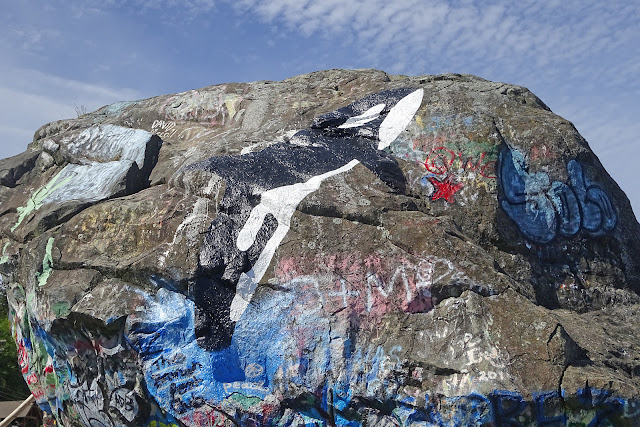We call it Big Rock. Of course; the first thing we notice about it is its size: huge. It sits at the top of the beach, looming. 10 metres high, and wider than it is tall; it probably weighs around 8000 tons.
 |
| The south face. The poles have been left by climbers and graffiti artists. Every so often, someone erects a driftwood sculpture on the top. |
I have been driving by the rock several times a week for two years now, and had never stopped before to look at it properly until a couple of days ago. High time.
 |
| North face. Current graffiti includes a dragonfly and umpteen "We were here" messages. |
Some 10 to 15 thousand years ago, most of Vancouver Island was weighed down by ice up to 2 kilometres thick, so heavy that it pushed the land down under the sea. And for those thousands of years, the ice collected rock and debris from the mountains and dragged or pushed it down towards the sea.
The ice melted finally, the land rose, and Big Rock was left stranded on the shore, probably hundreds of kilometres from its source. (A glacier moves about 30 cm. per day: calculate that over 1,000 years!) Geologists call these glacier leftovers "erratics".
 |
| Grass and moss growing on the inland top side. |
A landmark so obvious is bound to collect legends. Some First Nations stories explain the rock as a grizzly that tried to jump over from Quadra Island and didn't make it; others say it's a beached whale, condemned to stand on the shore forever as punishment for swallowing a fisherman off Mitlenatch Island.
 |
| Graffiti comes and goes, but the painting of the whale is always renewed. |
 |
| Lichen on the shoreward side, above the reach of salt water. |
I had read that there is a benchmark embedded in the rock. I walked around the rock, searching carefully; on the third circuit, I found it, a metal plaque, about 3 inches across, half hidden under several layers of paint. (I tried to scrape off the red paint with a stone, and just exposed the blue underneath. I gave up.)
 |
| I can't read what it says. The horizontal line marks sea level. |
(Now that I know where it is, I can see it in the second photo above; low down on the sunny side, near the logs, just under a white curve. All around the rock, the graffiti is faded below this line; it's underwater at high tide.)
 |
| Under a rock overhang, I found this perfectly preserved crane fly, in a skimpy spider's web. The sharply pointed tip of the abdomen identifies her as a female. |








I love reading about this rock and the glacial history of Vancouver Island. The rock is beautiful, but really too bad about all that graffiti.
ReplyDeleteReminds me of the white rock on the beach in White Rock.
ReplyDelete"The city of White Rock, BC is named after this local landmark, which is estimated to weigh 486 tonnes. The rock is located on the beach of Semiahmoo Bay. It is not naturally white but it has been painted white since the 19th century so that it could be used for navigational purposes." From a geochaching site.
DeleteWhen I was a kid in White Rock, the rock was white, but not quite so white. There's another erratic on the shore between Crescent Beach and Kwomais Point that is also painted white. (Although last time I was there, someone had added pink.)